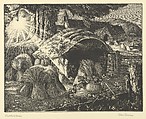Martin's Hovel
Robin Tanner British
Not on view
In 1924, while working as a teacher, Tanner began to study etching at Goldsmiths College, University of London. Two years later, he saw Samuel Palmer's prints exhibited at the Victoria and Albert Museum, and soon afterward, he produced Martin's Hovel. Its reverence for pastoral life and use of elements such as thatch, shocks of corn, ancient elms, and transfiguring light are deeply indebted to Palmer. Tanner's teacher, Stanley Anderson, initially criticized the print, calling the setting sun a "blasted searchlight." However, once he learned that Tanner had carefully based the design on studies made in Wiltshire, he supported the plate's progress. The hovel, or midday shelter, had been built by a cattleman in the corner of a farmyard at Allington. The church was adapted from Saint Nicholas's, Biddestone, and the elms were based on some that Tanner saw growing on a wall in Corsham.
Due to rights restrictions, this image cannot be enlarged, viewed at full screen, or downloaded.


